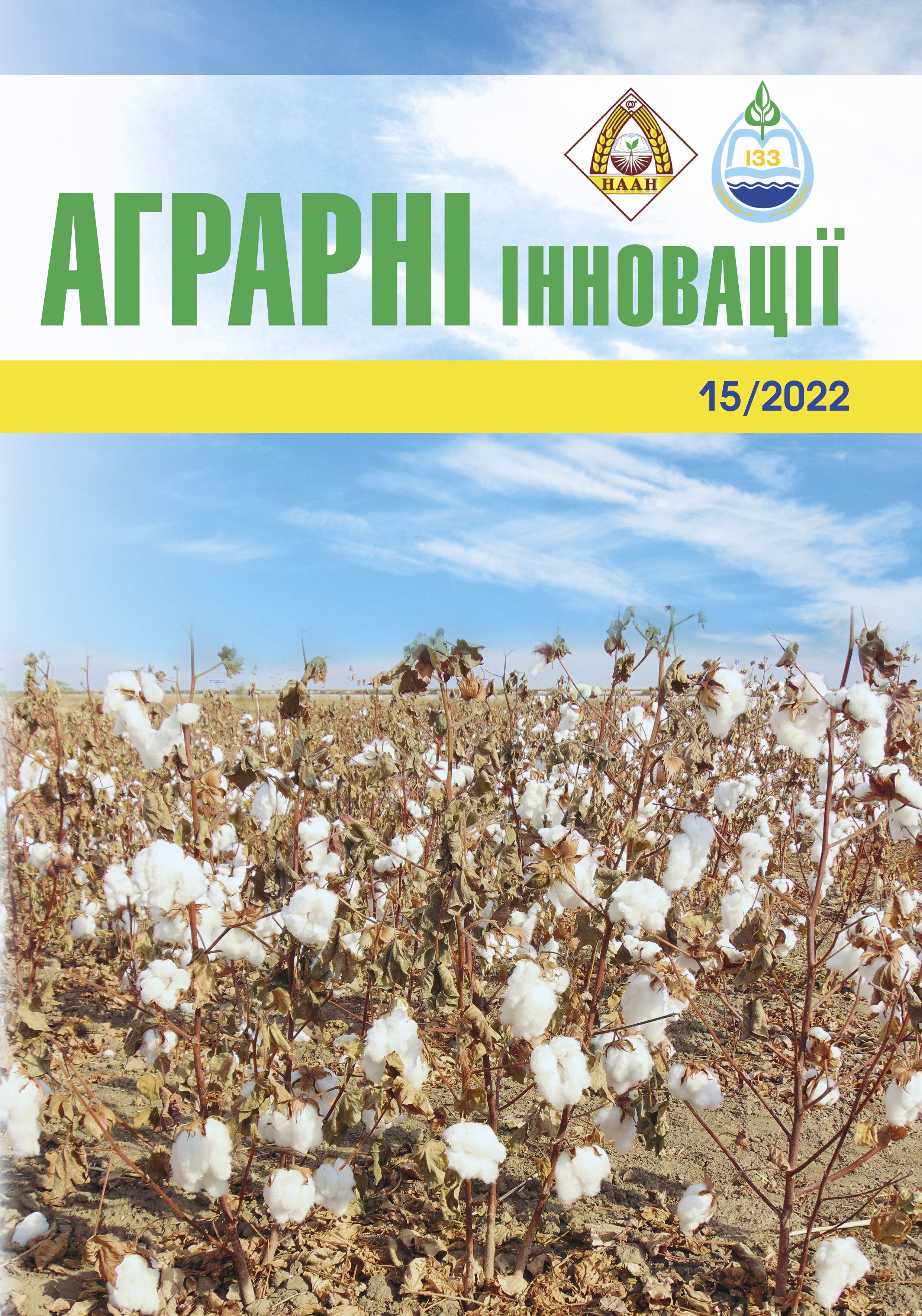The formation of productivity for hazelnut depending on the activity of photosynthesis
Abstract
The global trend is the rapid growth of hazelnut plantingareas, and there is a significant increase in the numberof people who directly include hazelnuts in their diet asa source of valuable nutritional elements, rather than consuming confectionery products. Purpose. The purposeof the research was to determine the most productiveand suitable varieties of hazelnuts in the conditions ofthe northern part of the Steppe of Ukraine - a zone withinsufficient capture and a sharply continental climate, whichwas previously considered not entirely suitable for thistype of activity. Methods: The research was carried out onproduction hazelnut plantations. The technology of growinghazelnuts in the experiment corresponded to the generallyaccepted for cultivation zones in Ukraine. Accounting forthe harvest of hazelnuts was carried out by continuousdivisional harvesting. Evaluation of photosynthetic activitywith the device and illumination of the crown was carriedout. Results. The Barcelona variety should not be grownin the conditions of the region. The definitely correctsolution is to use the variety Galle and, possibly, the varietyKosford in production plantations. The variety Catalonskyistill needs to be researched in this direction. Predominantefficiency belongs to the central part of the crown, whichis more promising with regard to future yield and is morerelated to this feature. The efficiency of use is a significantindicator that affects further productivity even at this levelof rather approximate research. Of great importance forthe formation of SPAD productivity and the ability to usethe light flow of the central part of the crown. All otherparameters were invalid. The first group included theless successful varieties Catalonskyi and Barcelonskyi,which did not differ significantly in the factor space, thevarieties Kosford and Galle stood out separately, it can beconsidered that these two genotypes are more promising,but there are significant differences in the formation ofproductivity by them and the features of the use of worldenergy and photosynthetic activity. Findings. The varietiesGalle and Kosford (especially the first) are promising forcultivation in the Northern Steppe zone in terms of thepossibilities of using global energy, the activity of the crownin the formation of the crop and the photosynthetic activityof the leaves. The ability to use the world's energy is clearlygenetically mediated and does not depend only on the waythe crown is cut.
References
2. Bodaghabadi M.B., Faskhodi A.A., Salehi M.H., Hosseinifard S.J., Heydari M. (2019). Soil suitability analysis and evaluation of pistachio orchard farming, using canonical multivariate analysis. Scientia Horticulturae, 246, 528–534. https://doi.org/10.1016/j.scienta.2018.10.069
3. Calà E., Fracchia A., Robotti E., Gulino F., Gullo F., Oddone M., Massacane M., Cordone G., Aceto, M. (2022). On the Traceability of the Hazelnut Production Chain by Means of Trace Elements. Molecules, 27, 3854. https://doi.org/10.3390/molecules27123854
4. Campa N.A., Rodríguez M.R, Suárez V.B., Ferreira, J.J. (2021). Variation of Morphological, Agronomic and Chemical Composition Traits of Local Hazelnuts Collected in Northern Spain. Frontiers Plant Science, 12, 659510. https://doi.org/10.3389/fpls.2021.659510
5. Črepinšek Z., Stampar F., Kajfež-Bogataj L., Solar A. (2011). The response of Corylus avellana L. phenology to rising temperature in north-eastern Slovenia. International Journal of Biometeorology, 56, 681–694. https://doi.org/10.1007/s00484-011-0469-7
6. Cristofori V., Pica A.L., Silvestri C., Bizzarri S. (2018). Phenology and yield evaluation of hazelnut cultivars in Latium region. Acta Horticulturae, 1226, 123–130. https://doi.org/10.17660/ActaHortic.2018.1226.17
7. Di Lena B., Curci G., Vergni L., Farinelli D. (2022). Climatic Suitability of Different Areas in Abruzzo, Central Italy, for the Cultivation of Hazelnut. Horticulturae, 8, 580. https://doi.org/10.3390/horticulturae8070580
8. Erbaş N., Çınarer G., Kılıç K. (2022). Classification of hazelnuts according to their quality using deep learning algorithms. Czech Journal Food Science, 40, 240–248. https://doi.org/10.17221/21/2022-CJFS
9. Jenderek M.M., Serimian J.C., Postman J.D., Hummer K.E., Yeater K.M. (2022). Yield and nut characteristics of hazelnut genotypes grown in San Joaquin Valley. California. Crop Science, 62(3), 1188–1199. https://doi.org/10.1002/csc2.20720
10. Jha P.K., Materia S., Zizzi G., Costa-Saura J.M., Trabucco A., Evans J., Bregaglio S. (2021). Climate change impacts on phenology and yield of hazelnut in Australia. Agricultural Systems, 186, 102982. https://doi.org/10.1016/j.agsy.2020.102982
11. Guiné R.P.F., Correia P. (2020). Hazelnut: A Valuable Resource. International Journal of Food Engineering, 6, 67–72. https://doi.org/10.18178/ijfe.6.2.67-72
12. Giulia T., Vallauri G., Pavese V., Valentini N., Ruffa P., Botta R. Marinoni D.T. (2022). Identification of the hazelnut cultivar in raw kernels and in semi-processed and processed products. European Food Research and Technology, 248, 2431–2440. https://doi.org/10.1007/s00217-022-04058-z
13. Kizilkaya R., Dumbadze G., Gülser C., Jgenti L. (2022). Impact of NPK fertilization on hazelnut yield and soil chemical-microbiological properties of Hazelnut Orchards in Western Georgia. Eurasian Journal of Soil Science, 11(3), 206–215. https://doi.org/10.18393/ejss.1060314
14. Krol K., Gantner M., Piotrowska A. (2019). Morphological traits, kernel composition and sensory evaluation of hazelnut (Corylus avellana L.) cultivars grown in Poland. Agronomy, 9, 703. https://doi.org/10.3390/agronomy9110703
15. Mehlenbacher S.A., Molnar T. (2021). Hazelnut Breeding. Plant Breeding Reviews, 62(3), 9–141. https://doi.org/10.1002/9781119828235.ch2
16. Milošević T., Milošević N. (2017). Determination of size and shape features of hazelnuts using multivariate analysis. Acta Scientiarum Polonorum: Hortorum Cultus, 16, 49–61. https://doi.org/10.24326/asphc.2017.5.6
17. Nepal A., Tashi S., Chhetri R., Dorji T., Dorji U., Sapkota S. (2022). Impacts of Climate Change on Hazelnut (Corylus avellane L.) Cultivation in Bhutan. Vietnam Journal of Agricultural Sciences, 5(2), 1445–1455. https://doi.org/10.31817/vjas.2022.5.2.02
18. Nera E., Paas W., Reidsma P., Paolini G., Antonioli F., Severini S. (2020). Assessing the Resilience and Sustainability of a Hazelnut Farming System in Central Italy with a Participatory Approach. Sustainability, 12, 343. https://doi.org/10.3390/su12010343
19. Orlandi F., Ranfa A., Ruga L., Fornaciari M. (2019). Hazelnut phenological phases and environmental effects in two central Italy areas. Journal of Agricultural Meteorology, 75(3), 137–143. https://doi.org/10.2480/agrmet.D-18-00036
20. Vesali F., Omid M., Mobli H., Kaleita A. (2017). Feasibility of using smart phones to estimate chlorophyll content in corn plants. Photosynthetica, 55, 603–610. doi: 10.1007/s11099-016-0677-9






